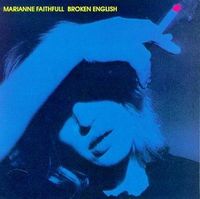 in 1979. It is considered by many commentators to be the singer’s definitive recording, whilst Faithfull herself describes it in her autobiography as "the masterpiece". Containing some of her most famous songs, including the title track and "The Ballad of Lucy Jordan", the album was also notable for the controversy surrounding the final number "Why D’Ya Do It?".
in 1979. It is considered by many commentators to be the singer’s definitive recording, whilst Faithfull herself describes it in her autobiography as "the masterpiece". Containing some of her most famous songs, including the title track and "The Ballad of Lucy Jordan", the album was also notable for the controversy surrounding the final number "Why D’Ya Do It?". Faithfull’s immediately preceding albums, Dreaming My Dreams and Faithless (which in fact shared some tracks), had been in a relatively gentle folk or country and western style. The music on the new album was a far more contemporary fusion of rock, punk, new wave and dance, with liberal use of synthesizers. Critics also noted that Faithfull’s voice, after a number of years of drug abuse, had a lower register and a more world-weary quality than in the past, well suited to the often raw emotions expressed in the songs.
The album’s title track took inspiration from terrorist figures of the time, particularly Ulrike Meinhof of the Baader-Meinhof group. "Guilt" was informed by the Catholic upbringing of the singer and her composer Barry Reynolds. "The Ballad of Lucy Jordan", originally performed by Dr Hook, was a melancholy tale of middle class disillusionment; Faithfull's version became something of anthem and was used to appropriate effect on the soundtracks to the films Montenegro (1981) and Thelma and Louise (1991). "What’s the Hurry?" was described by Faithfull as reflecting the everyday desperation of the habitual drug user. Her cover of John Lennon’s "Working Class Hero", recorded as a tribute to her own heroes such as Mick Jagger and Keith Richards, David Bowie and Iggy Pop, and Lennon himself, was widely praised.
The last track, "Why D’Ya Do It?", was a caustic response to a lover’s betrayal set to a grinding tune inspired by Jimi Hendrix’s recording of Bob Dylan’s "All Along the Watchtower". Writer Heathcote Williams had originally intended the lyric for Tina Turner but Faithfull succeeded in convincing him that Turner would never record such a number. Its plethora of four-letter words and explicit references to oral sex caused controversy and led to a ban in Australia, where local pressings of the LP were released with smooth vinyl in place of the track and a 'bonus' 45 single as compensation (the ban did not extend to import copies). Whilst the song’s notoriety arguably guaranteed a favourable reception from contemporary critics, reappraisals over the years still tend to regard it as one of the album’s highlights.
The Official Website of Marianne Faithfull










0 COMMENTS:
Post a Comment